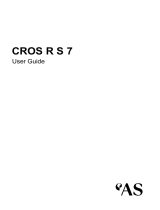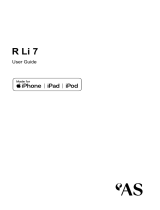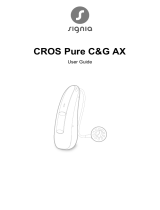Page is loading ...

CROS SR Li 7
User Guide

2
Content
Welcome 4
Your CROS transmitter 5
Components and names 7
Controls 8
Hearing programs 8
Signal tones 8
Daily use 9
Inserting and removing the transmitter 9
Turning on and o 12
Switching to andby mode 13
Changing the hearing program 14
Bluetooth 14
Charging 15
Maintenance and care 16
Transmitter 16
Ear pieces 18
Professional maintenance 20

3
Further information 21
Accessories 21
Explanation of symbols 21
Operating, transport, and orage conditions 22
Disposal information 23
Troubleshooting 24
Conformance information 24
Country-specic information 27
Important safety information 28
Lithium-ion rechargeable battery (power cell) 28
Personal safety 30
Product safety 35
Service and warranty 39

4
Welcome
Thank you for choosing one of our hearing inrument
accessories.
This guide, along with support from your Hearing Care
Professional, will help you underand the advantages
and greater quality of life this accessory oers.
CAUTION
It is important to read this user guide thoroughly
and completely. Follow the safety information to
avoid damage or injury.
It is also important to read and follow the user
guide and safety manual for the hearing inrument
you use with this accessory.

5
Your CROS transmitter
CROS solutions are designed for people with profound
hearing loss in one ear which can not be aided with a
hearing inrument. A CROS transmitter worn on this
ear captures sound from this side and transmits it to
the hearing inrument on the other ear. This allows the
wearer of the hearing inrument to hear sounds from
both sides.
CROS transmitter hearing inrument

6
Two solutions are available:
● CROS solution:
For people with normal hearing in one ear and
profound hearing loss in the other. Sounds from the
side with hearing loss are captured and transmitted
wirelessly to the good-hearing side.
● BiCROS solution:
For people with profound hearing loss in one ear
and less severe hearing loss in the other. Sounds
from the more severe hearing loss side are captured
and transmitted wirelessly to the better-hearing side.
The hearing inrument processes and amplies the
sounds from both sides.
The CROS transmitter works with our specic wireless
hearing inruments. Your Hearing Care Professional will
advise you on the compatible models.
NOTICE
This user guide only applies to the CROS
transmitter. Your hearing inrument has a separate
user guide.

7
Components and names
➊
➊Ear piece
➋Receiver
➌Receiver cable
➍Microphone openings
➎Charging contact
➏Side indicator
(red = right, blue = left)
You can use the following andard ear pieces:
Standard ear pieces Size
Sleeve 3.0, Vented, Closed,
Power
Eartip 3.0 Open
Eartip 3.0 Tulip
You can easily exchange the andard ear pieces. Read
more in section "Maintenance and care".

8
Controls
Your CROS transmitter has no controls. If you want to
adju the volume or switch hearing programs manually,
you can ask your Hearing Care Professional about a
remote control option.
Hearing programs
1
2
3
4
5
6
Read more in section "Changing the hearing program".
Signal tones
Signal tones of the CROS transmitter - like a low battery
beep - are sent to the hearing inrument.
Ask your Hearing Care Professional to congure the
signal tones.

9
Daily use
Inserting and removing the transmitter
Your hearing inruments have been ne-tuned for your
right and left ear. Colored markers
indicate the side:
● red marker = right ear
● blue marker = left ear
Inserting the device:
XFor Sleeves, take care that the
bend of the Sleeve is in line with the bend of the
receiver cable. See the following illurations.
Correct:
Incorrect:

10
XHold the receiver cable at the bend closer to the
ear piece.
XCarefully push the ear piece in
the ear canal ➊.
XTwi it slightly until it sits well.
Open and close your mouth to
avoid accumulation of air in the
ear canal.
XLift the device and slide it over
the top of your ear ➋.
● It may be helpful to insert the right device with
the right hand and the left device with the left
hand.
● If you have problems inserting the ear piece,
use the other hand to gently pull your earlobe
downwards. This opens the ear canal and eases
insertion of the ear piece.

11
The optional retention rand helps to securely retain the
ear piece in your ear. To position the retention rand:
XBend the retention rand and
position it carefully into the
bottom of the bowl of your ear
(refer to the picture).
Removing a device:
XLift the device and slide it over
the top of the ear ➊.
XIf the device is equipped with
a cuom shell or a mold,
remove it by pulling the small
removal cord toward the back
of the head.
XFor all other ear pieces: Grip the receiver in the
ear canal with two ngers and pull it carefully out ➋.
Do not pull the receiver cable.
Clean and dry the device after usage. Read more in
section "Maintenance and care".

12
Turning on and o
You have the following options to turn your device on or
o.
Via charger:
XTurning on: Take the device out of the charger.
The artup melody is played in your hearing
inrument. The default volume and hearing program
are set.
XTurning o: Place the device in the charger.
For details refer to the charger's user guide.
Note that the charger mu be turned on.

13
Switching to andby mode
Via remote control or smartphone app, you can switch
your device to andby mode. This mutes the device.
When you leave andby mode, the previously used
volume and hearing program are set.
Note:
● In andby mode, the device is not turned o
completely. It draws some power.
Therefore we recommend to use andby mode only
for a short period of time.
● If you want to leave andby mode, but the remote
control or app is not at hand: Turn your device o and
on again (by shortly placing it in the charger until the
green LED lights up). In this case, the default volume
and hearing program are set.

14
Changing the hearing program
Depending on the liening situation, your device
automatically adju their sound.
Your device may also have several hearing programs
which allow you to change the sound, if needed. An
optional signal tone can indicate the program change.
XTo change the hearing program, refer to section
"Hearing programs" for a li of your hearing programs.
The default volume is applied.
Bluetooth
Your device is equipped with Bluetooth®* wireless
technology.
In an airplane, the use of Bluetooth functionality may
be rericted, especially during take-o and landing. If
this is the case, you can switch o Bluetooth wireless
technology in your device via the smartphone app.
* The Bluetooth word mark and logos are owned by the Bluetooth SIG, Inc., and any
use of such marks by WS Audiology Denmark A/S of this product is under licenses.
Other trademarks and trade names are those of their respective owners.

15
Charging
For your CROS transmitter, you have the choice between
Connexx Slim-RIC Travel Charger 2 ➊ or Connexx
Charging+ Station SR ➋.
XTo charge your transmitter, place it in the charger.
XFollow the inructions in the charger's user guide. You
can also nd useful tips for charging in the charger's
user guide.
Low power indication
You will hear an alert signal in your hearing inrument to
indicate that the lithium-ion rechargeable battery of your
transmitter is running low. The signal will be repeated
every 20 minutes. Depending on the usage of your
hearing inruments, you have approximately 1.5 hours
to charge your hearing inruments before they op
working.
Note that the power cell runtime is reduced if too many
features are used simultaneously.

16
Maintenance and care
To prevent damage it is important that you take care of
your device and follow a few basic rules, which will soon
become a part of your daily routine.
Transmitter
Cleaning
Your device has protective coating. However, if not
cleaned regularly you may damage the device or cause
personal injury.
XClean your device daily with a soft, dry tissue.
XNever use running water or immerse the
device in water.
XNever apply pressure while cleaning.
XDo not use alcoholic solvent on the charging contact.
XTo avoid corrosion, use a soft and dry tissue to wipe
o sweat or liquid from the charging contact or device
before inserting this in the charger.
XAsk your Hearing Care Professional for recommended
cleaning products, special care sets, or more
information on how to keep your device in good
condition.

17
Drying
You can use conventional products to dry your device or
the optional Connexx Charging+ Station SR. Ask your
Hearing Care Professional for recommended drying
products and for individual inructions on when to dry
your device.
Storage
● Short-term orage (up to several days):
Turn o your device by placing it in the powered
charger.
The charger mu be on. If the charger is not on and
you place your devices in the charger, the devices
are not turned o. Note that when you turn o the
CROS transmitter via a remote control or smartphone
app, the device is not turned o completely. It is in
andby-mode and ill draw some power.
● Long-term orage (weeks, months, ...):
Fir, fully charge your CROS transmitter. Leave it in
the Connexx Slim-RIC Travel Charger 2 with the lid
closed. Once the device is fully charged, the charger
and the CROS transmitter are turned o automatically.
We recommend using drying products while oring
the device.
At 6 month intervals you will have to charge the device
to avoid an unrecoverable deep-discharge of the

18
rechargeable lithium-ion battery. Deep-discharged
batteries cannot be charged anymore and they have
to be replaced. We recommend recharging more
frequently than at intervals of 6 months.
Observe the orage conditions in section "Operating,
transport and orage conditions".
Ear pieces
Cleaning
Cerumen (ear wax) may accumulate on the ear pieces.
This may aect sound quality. Clean the ear pieces daily.
For all types of ear pieces:
XClean the
ear piece right
after removal
with a soft and
dry tissue.
This prevents
that cerumen
becomes dry
and hard.
Exchanging
Exchange andard ear pieces approximately every
three months. Replace them sooner if you notice
cracks or other changes. The procedure for exchanging

19
andard ear pieces depends on the type of ear piece.
In section "Components and names", your Hearing Care
Professional has marked your type of ear piece.
XTo remove the old Eartip or Sleeve, follow the
illuration below. Be careful not to pull the receiver
cable.
XTake particular care that
the new Eartip or Sleeve
covers the retention rings
of the receiver fully.
XCheck the rm t of the
new Eartip or Sleeve.

20
Professional maintenance
Your Hearing Care Professional can perform a thorough
professional cleaning and maintenance.
Cuom-made ear pieces and wax lters should
be exchanged as needed by your Hearing Care
Professional.
Ask your Hearing Care Professional for your individual
recommendation of maintenance intervals and for
support.
/

















